April 2020 | Vol. 162, issue 2
AVIAN MIGRATION AND MOVEMENT
Special themed issue
From long-haul to daily commute, the annual and daily journeys of birds are one of the most fascinating aspects of their lives. For decades ornithologists have been systematically ringing birds to uncover the mystery of migration and, more recently, rapid advances in tracking technology have allowed us to follow the movement patterns of some of our smallest passerines to our largest raptors and seabirds. It is therefore no surprise that research aimed at understanding the movement ecology and behaviour of birds is one of the most important fields in ornithology today.
We are therefore delighted to have compiled a special themed issue on Avian Migration and Movement which brings together an outstanding collection of some 25 articles on this topic from leading researchers across the World. In this special issue of IBIS, the spatial and temporal patterns of migration and movement are examined in detail across a wide range of taxonomic groups. Indeed, these studies demonstrate how complementary approaches have been able to advance our knowledge of movement ecology, provide new insights into the behaviour of birds on migration and allow us to understand more clearly threats to birds during flight.
The articles we have selected below highlight the main themes featured in Avian Migration and Movement. Several studies demonstrate the value of international ringing efforts for migration research, and how stable isotope analysis of feathers can complement ringing to determine the origins of migrating species. Advances in computing power now provide researchers with the tools to analyse large datasets and we give one example of how modelling climate-niches provides better understanding of the distribution of many migrating species. Finally, surprising new insights into the migration and movement behaviour of many birds have been achieved using new tracking technology and therefore we feature here several examples using the latest geolocator and GPS telemetry devices, including a raptor study analysing detailed flight behaviour to predict collision risk from wind turbines. We hope these highlights will encourage you to read the full issue.
- Population‐specific migratory strategies of Twite in Western Europe
Jamie Dunning, Tom Finch, Angus Davison, Kate L. Durrant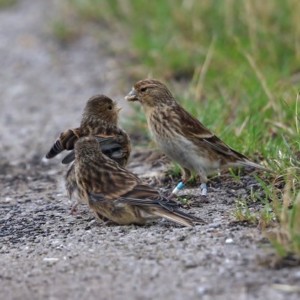 Connectivity between breeding populations and their non‐breeding sites has long been an important focus of ringing schemes across the World. Using mark‐recapture data from the EUring data bank Jamie Dunning and colleagues were able to provide a comprehensive description of the non‐breeding range of Twite within Western Europe. They were able to show that Twite from different parts of the British breeding range used different non‐breeding areas while continental birds used similar non‐breeding areas. Dunning et al. therefore found that there was no overlap during the non‐breeding season between British and continental Twite and indicate that this may have important consequences for their demography and population structure.
Connectivity between breeding populations and their non‐breeding sites has long been an important focus of ringing schemes across the World. Using mark‐recapture data from the EUring data bank Jamie Dunning and colleagues were able to provide a comprehensive description of the non‐breeding range of Twite within Western Europe. They were able to show that Twite from different parts of the British breeding range used different non‐breeding areas while continental birds used similar non‐breeding areas. Dunning et al. therefore found that there was no overlap during the non‐breeding season between British and continental Twite and indicate that this may have important consequences for their demography and population structure.
- Natal origins and timing of migration of two passerine species through the southern Alps: inferences from multiple stable isotopes (δ2H, δ13C, δ15N, δ34S) and ringing data
Alessandro Franzoi, Luana Bontempo, Kevin J. Kardynal, Federica Camin, Paolo Pedrini, Keith A. Hobson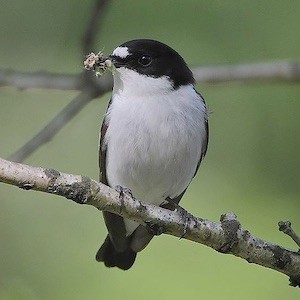 Understanding migratory connectivity during the annual cycle is fundamental to bird conservation. Working in the Italian Alps Alessandro Franzoi and collaborators successfully established the natal origins of two migratory passerines, the European Pied Flycatcher and European Robin captured during autumn migration. This was achieved by combining feather hydrogen and sulphur isotope analysis with ringing recoveries to reconstruct their natal locations. Their studies indicated that the origin of most individuals of both species were in central and north‐eastern Europe and Franzoi et al. suggest that this combined approach is a useful way of defining catchment areas and migratory connectivity.
Understanding migratory connectivity during the annual cycle is fundamental to bird conservation. Working in the Italian Alps Alessandro Franzoi and collaborators successfully established the natal origins of two migratory passerines, the European Pied Flycatcher and European Robin captured during autumn migration. This was achieved by combining feather hydrogen and sulphur isotope analysis with ringing recoveries to reconstruct their natal locations. Their studies indicated that the origin of most individuals of both species were in central and north‐eastern Europe and Franzoi et al. suggest that this combined approach is a useful way of defining catchment areas and migratory connectivity.
- Seasonal climatic niches diverge in migratory birds
Raquel Ponti, Angel Arcones, Xavier Ferrer, David R. Vieites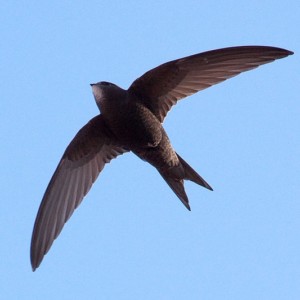 Do breeding and non-breeding seasonal ranges have the same climatic conditions for migrant birds? This is the question that Ponti et al. examined using data for 355 bird species migrating through Eurasian–African flyways. Interestingly, they found there was no or little overlap between breeding and non‐breeding climatic niches in more than 80% of these species. Furthermore, longer distance migrants had less climatic niche overlap compared with species that had smaller migration distances. As changes in climate may be different between breeding and non-breeding sites Ponti et al. believe the impact of global change is likely to influence migrant birds differently in each of their seasonal ranges.
Do breeding and non-breeding seasonal ranges have the same climatic conditions for migrant birds? This is the question that Ponti et al. examined using data for 355 bird species migrating through Eurasian–African flyways. Interestingly, they found there was no or little overlap between breeding and non‐breeding climatic niches in more than 80% of these species. Furthermore, longer distance migrants had less climatic niche overlap compared with species that had smaller migration distances. As changes in climate may be different between breeding and non-breeding sites Ponti et al. believe the impact of global change is likely to influence migrant birds differently in each of their seasonal ranges.
- Overland movement and migration phenology in relation to breeding of Arctic Terns
Chris P. F. Redfern, Richard M. Bevan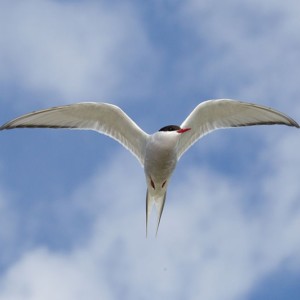 It is often assumed that seabirds do not frequently migrate across land, but tracking data shows us otherwise. Chris Redfern and Richard Bevan tracked Arctic terns breeding on the Farne Islands in NE England using miniature light-level geolocators. What these tracks revealed was that birds arrived and departed from their colony overland via the Irish Sea, rather than taking coastal routes along the east coast of the UK and through the English Channel. Some birds also entered the North Atlantic by crossing Ireland rather than through the Irish Sea. Results also showed that birds arrived around 15 days before the first eggs were laid in the colony and departure at the end of the season was not markedly influenced by breeding success. Redfern and Bevan therefore highlight that overland migration may be more common for seabirds than previously thought.
It is often assumed that seabirds do not frequently migrate across land, but tracking data shows us otherwise. Chris Redfern and Richard Bevan tracked Arctic terns breeding on the Farne Islands in NE England using miniature light-level geolocators. What these tracks revealed was that birds arrived and departed from their colony overland via the Irish Sea, rather than taking coastal routes along the east coast of the UK and through the English Channel. Some birds also entered the North Atlantic by crossing Ireland rather than through the Irish Sea. Results also showed that birds arrived around 15 days before the first eggs were laid in the colony and departure at the end of the season was not markedly influenced by breeding success. Redfern and Bevan therefore highlight that overland migration may be more common for seabirds than previously thought.
- Breeding status influences timing but not duration of moult in the Northern Fulmar
Antoine Grissot, Isla M. Graham, Lucy Quinn, Vegard S. Bråthen, Paul M. Thompson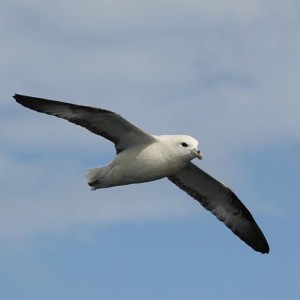 In seabirds, the phenology of life-cycle events are not well known during the non‐breeding period. To fill this knowledge gap Antoine Grissot and colleagues used miniaturized saltwater immersion light‐based geolocators on Northern Fulmars to investigate moult phenology. As seabirds spend more time on the water during moult, moulting periods were determined from variation in the time that birds were in contact with saltwater. Grissot et al. found a sex difference in the geographical location of the moult, but not in its timing. However, the timing of moult did differ between individuals that had succeeded or failed in their previous breeding attempt, with successful breeders moulting later. There was also evidence of inter‐annual variation in moult duration. Grissot et al. conclude that geolocator deployments have vastly increased our understanding of pelagic seabirds and this work in particular shows how activity data can add considerable value to tracking studies, by identifying locations and key phases of the annual cycle when seabirds may be at particular risk.
In seabirds, the phenology of life-cycle events are not well known during the non‐breeding period. To fill this knowledge gap Antoine Grissot and colleagues used miniaturized saltwater immersion light‐based geolocators on Northern Fulmars to investigate moult phenology. As seabirds spend more time on the water during moult, moulting periods were determined from variation in the time that birds were in contact with saltwater. Grissot et al. found a sex difference in the geographical location of the moult, but not in its timing. However, the timing of moult did differ between individuals that had succeeded or failed in their previous breeding attempt, with successful breeders moulting later. There was also evidence of inter‐annual variation in moult duration. Grissot et al. conclude that geolocator deployments have vastly increased our understanding of pelagic seabirds and this work in particular shows how activity data can add considerable value to tracking studies, by identifying locations and key phases of the annual cycle when seabirds may be at particular risk.
- Collision risk of Montagu’s Harriers with wind turbines derived from high‐resolution GPS tracking
Tonio Schaub, Raymond H.G. Klaassen, Willem Bouten, Almut E. Schlaich, Ben J. Koks With the expansion of renewable energy developments measurements of flight altitude and avoidance behaviour of birds are needed to determine species‐specific collision risk with wind turbines. Tonio Schaub and colleagues used three‐dimensional GPS tracking data to investigate the collision risk of breeding male Montagu’s Harriers in the Dutch–German border region. They were able to show that 7% of flights of Montagu’s Harriers were within the rotor height range. Interestingly, Montagu’s Harriers showed clear avoidance behaviour and approached turbines less often than expected. However, risk assessment did predict a number of collisions and a proposed wind farm inside the core breeding area would increase mortality. Turbine design appears to be critical as low‐reaching modern turbines would more than double collisions but higher turbines would reduce impacts. Schaub et al. clearly demonstrated the great potential of high‐resolution GPS tracking for collision risk assessment and suggest that in contrast to current methods this would improve wind farm siting and turbine design.
With the expansion of renewable energy developments measurements of flight altitude and avoidance behaviour of birds are needed to determine species‐specific collision risk with wind turbines. Tonio Schaub and colleagues used three‐dimensional GPS tracking data to investigate the collision risk of breeding male Montagu’s Harriers in the Dutch–German border region. They were able to show that 7% of flights of Montagu’s Harriers were within the rotor height range. Interestingly, Montagu’s Harriers showed clear avoidance behaviour and approached turbines less often than expected. However, risk assessment did predict a number of collisions and a proposed wind farm inside the core breeding area would increase mortality. Turbine design appears to be critical as low‐reaching modern turbines would more than double collisions but higher turbines would reduce impacts. Schaub et al. clearly demonstrated the great potential of high‐resolution GPS tracking for collision risk assessment and suggest that in contrast to current methods this would improve wind farm siting and turbine design.
- Spatial and temporal movement of the Bearded Vulture using GPS telemetry in the Himalayas of Nepal
Tulsi R. Subedi, Juan M. Pérez‐García, Shahrul A.M. Sah, Sandesh Gurung, Hem S. Baral, Laxman P. Poudyal, Hansoo Lee, Simon Thomsett, Munir Z. Virani and José D. Anadón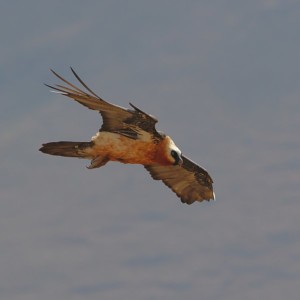 What are the movement patterns of the Bearded Vulture in the high‐altitude mountain ranges of Asia? To answer this question Tulsi Subedi with a team of international ornithologists tracked adult and immature vultures in the Annapurna Himalayan range in Nepal. This remarkable study found that birds foraged over a vast range of more than 60,000 km2. Territorial adults had small annual home‐ranges compared to immatures that wandered extensively and covered vast ranges of the mountains Subedi et al. show that both adult and immature Bearded Vulture ranges are larger here than in the Pyrenees and South Africa and suggest that the Annapurna population may breed at a lower density due to food availability.
What are the movement patterns of the Bearded Vulture in the high‐altitude mountain ranges of Asia? To answer this question Tulsi Subedi with a team of international ornithologists tracked adult and immature vultures in the Annapurna Himalayan range in Nepal. This remarkable study found that birds foraged over a vast range of more than 60,000 km2. Territorial adults had small annual home‐ranges compared to immatures that wandered extensively and covered vast ranges of the mountains Subedi et al. show that both adult and immature Bearded Vulture ranges are larger here than in the Pyrenees and South Africa and suggest that the Annapurna population may breed at a lower density due to food availability.
View all papers in this special issue
Sign up for content e-alertsImage credits
From top:
Twite © Peter Welch with permission from Twitter
Pied Flycatcher | Steve Garvie CC BY SA 2.0 Wikimedia Commons
Common Swift | pau.artigas CC BY SA 2.0 Wikimedia Commons
Arctic Tern | Andreas Trepte CC BY SA 2.5 Wikimedia Commons
Northern Fulmar | Avenue CC BY SA 3.0 Wikimedia Commons
Montagu’s Harrier | Ron Knight CC BY 2.0 Wikimedia Commons
Bearded Vulture | Derek Keats CC BY 2.0 Wikimedia Commons



